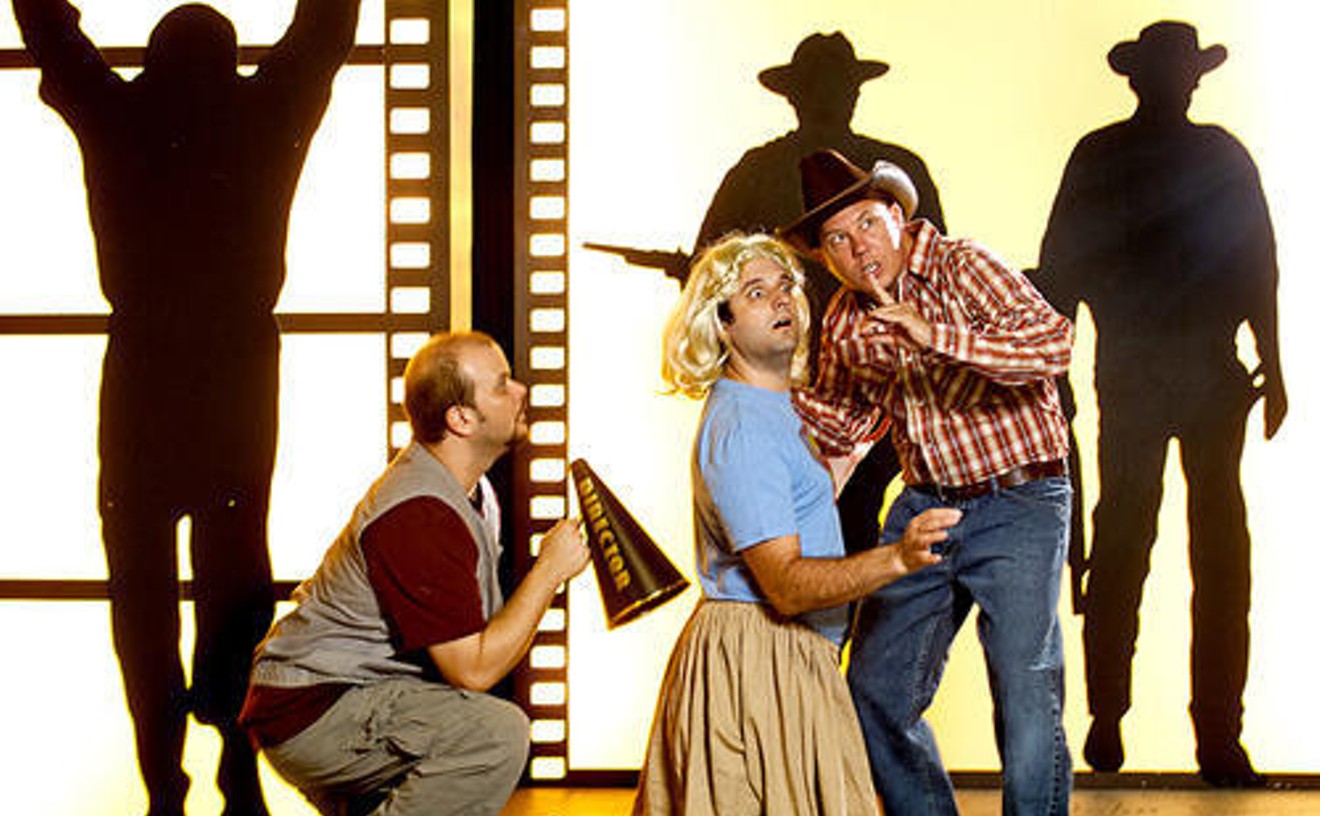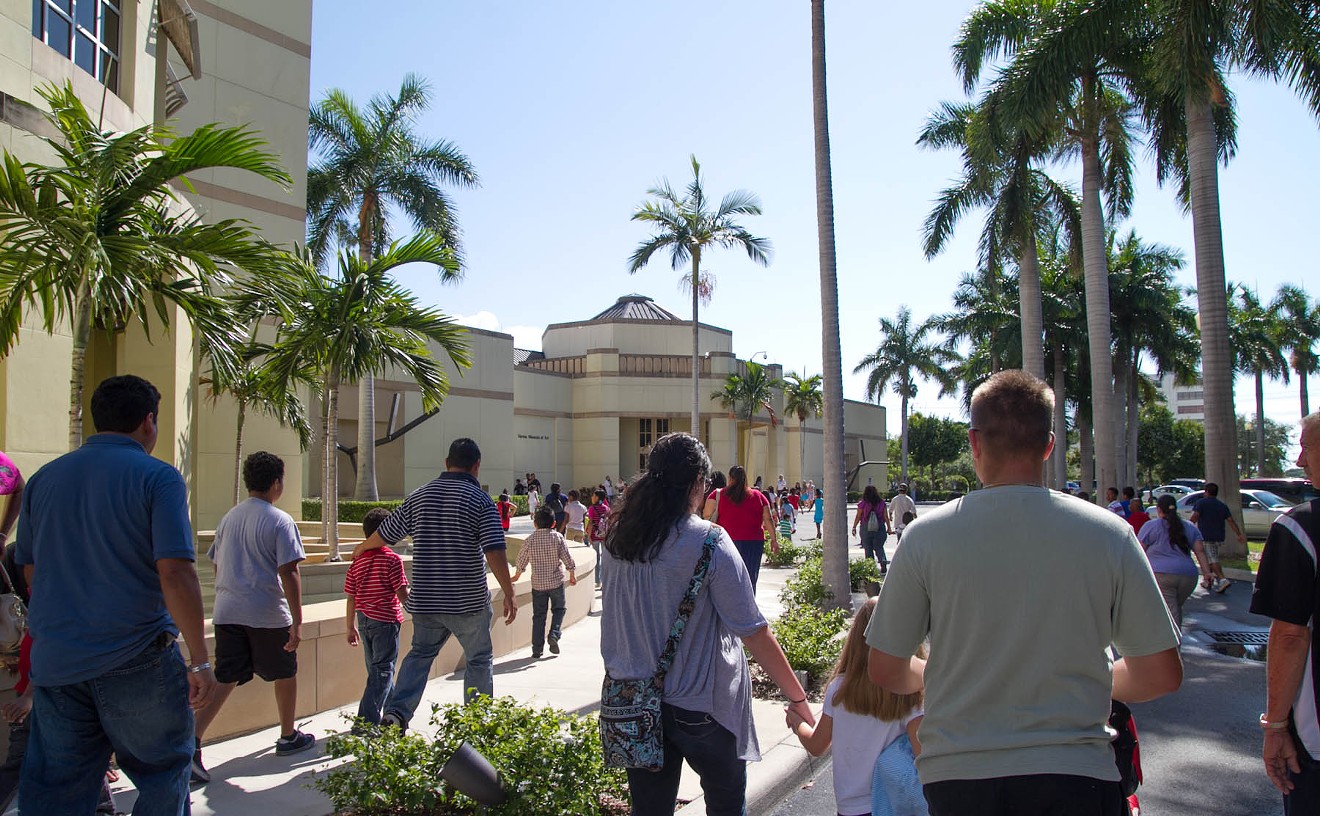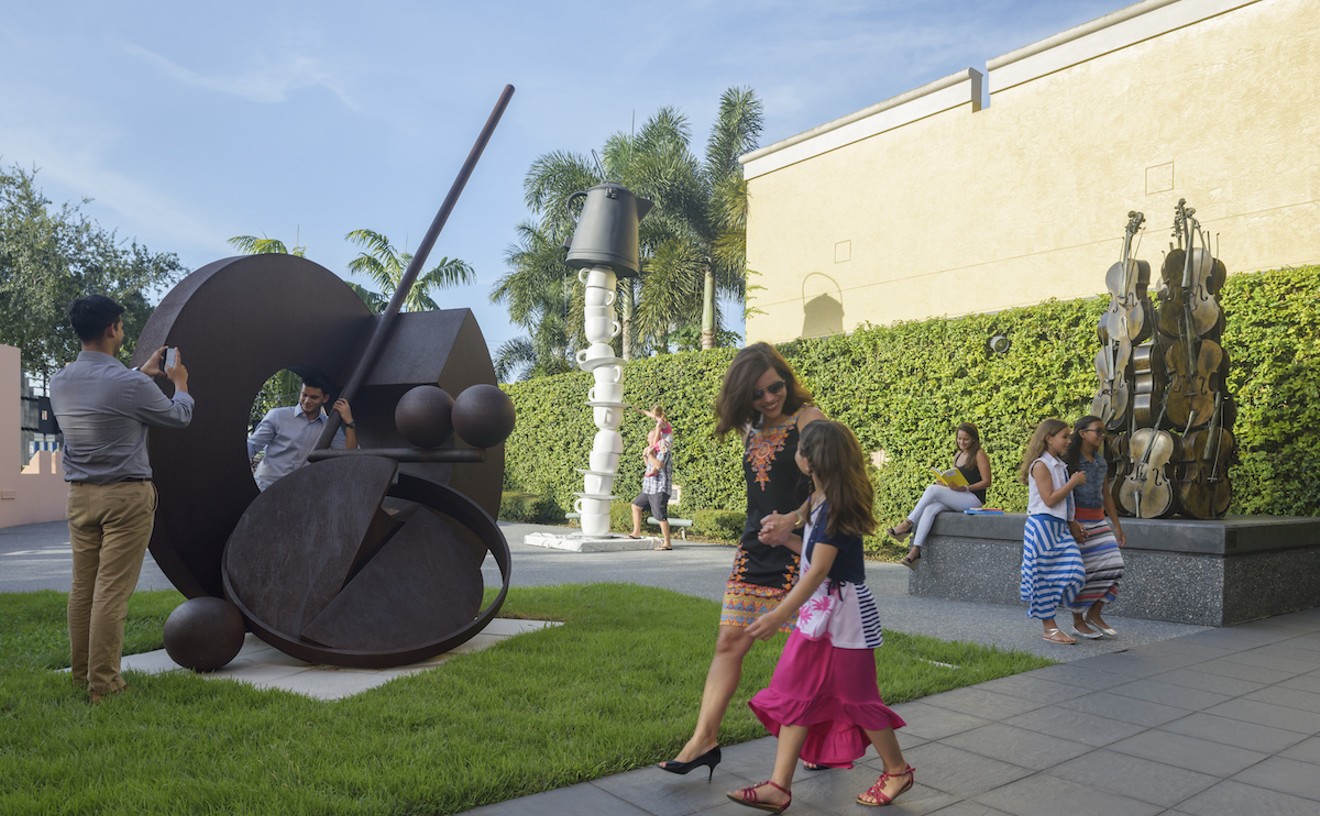If variety is indeed the spice of life, then this year's schedule at the Boca Museum was a buffet as satisfying as it was highly seasoned. There were crowd pleasers such as "Degas in Bronze: The Complete Sculptures" and "Shock of the Real: Photorealism Revisited." There was a massive and far-reaching group show, the "57th Annual All Florida Juried Competition and Exhibition," and a look at some historically significant photography, "I Shot Warhol Wesselmann Lichtenstein Rosenquist and Indiana." There was also a trio of exhibitions — "Visiones: 20th Century Latin Art," "Guillermo Trujillo: Panamanian Master," and "José Clemente Orozco: The Graphic Work" — that put the museum at the forefront of the year's trend in Latin-flavored art. But where the museum excelled this year was in its smaller shows: the aforementioned Trujillo and Orozco, a selection of Tiffany works from a private collection, a tiny but precise Duane Hanson retrospective, and a quick survey of South Florida's own latter-day pointillist, David Maxwell. And if that diverse menu proved inadequate, there was always the museum's second floor, most of which is devoted to the vast permanent collections and the pleasures they serve up on a daily basis.
Best Art Museum
Boca Raton Museum of Art
Best Artist to Return to South Florida
Enrique Martínez Celaya
This time last year, we were lamenting the still-fresh loss of Enrique Martínez Celaya, who had abruptly closed his studio in Delray Beach and moved his family back to Los Angeles. Alas, one fewer world-class artist in residence in South Florida. He didn't even hang around long enough to see the opening of his small but well-received exhibition at the Miami Art Museum. But the artist, who was born in Cuba and grew up in Spain and Puerto Rico, soon had second thoughts about being back in the thick of the art-world B.S. that had originally driven him from L.A. Now he's back in Delray, where he recently put the finishing touches on a show of stunning new work to ship off to the Sara Meltzer Gallery in New York. He wasn't able to get his spacious old digs back, but he settled into a smaller studio next door and hopes to find a bigger place eventually. Meanwhile, he continues to oversee the operation of his Whale & Star publishing house, work on new paintings, and prepare for a small retrospective of his work drawn from a private collection, which will be displayed at the Boca Raton Museum of Art at the end of 2009. Southern California's loss is our gain, again.
Best Band to Break Up in the Past 12 Months
The Remnants
Since its inception around 2004, the foursome known as the Remnants were live favorites across the South Florida rock-dive circuit. A grimy, swinging, rock 'n' roll outfit fronted by firecracker frontwoman Cynthia DuVall, the group described itself — quite appropriately — as "the Who fronted by Tina Turner." In fact, in 2005, New Times awarded DuVall Best Female Rock Vocalist, describing her as "the ass-kicking, sass-spewing, rock-star love child Janis and Iggy never had." Alas, day jobs and other real-life concerns led the Remnants to finally call it quits last year, giving South Florida a little less "maximum rock and soul" to go around.
Best Club DJ
Marvelous Kendall

Precious few of the best indie-rock bands see fit to drive their vans south of Gainesville, which is why we're grateful for Marvelous Kendall, one of the resident DJs for href="http://respectablestreet.com/">Respectable Street's Thursday-night party, Flaunt. A whole range of sensational DJs pay visits, but with Marvelous Kendall in the house weekly, you're guaranteed to get rocked just right. With his exquisite taste, he plucks out the newest and finest in the genre as if he had access to your current and future iPod. You thought you were the only one who knew about Alamo Race Track? Or the White Rabbits? Wash those tunes down with a $1 Pabst or, in no-nonsense indie-rock fashion, with a $3 shot. Since it's 18-and-up, you can even bring your kid brother or your under-21 girlfriend. There's plenty of room, and look at it this way: The more people who get hip to Flaunt, the more likely those indie bands are to venture a bit farther south on the next tour. It'll be thanks to guys like Marvelous Kendall.
- 518 Clematis St., West Palm Beach, 33401 Map
- 561-832-9999
- respectablestreet.com
Best Country Band
The Bikes
The Bikes play country music that Gram Parsons would be proud to listen to. The Deerfield fourpiece started out as an indie-rock band, but after the 2006 album Get Stolen, the Bikes took a twangy turn. The group's music has an Americana vibe reminiscent of great alt-rock bands like R.E.M., Drive-By Truckers, and Built to Spill. It's full of sullen vocals, rusty guitar licks, and assertive backbeats that you'd never confuse with contemporary pop country. But there's definitely a classic country bent to the group's lyrics: Lead singer Rick Ambrose delivers with the sort of resigned drawl that sounds as if he's sipping on a whiskey bottle midsong. And even when the Bikes do get to fiddlin', like on the track "Fumes," you never get the feeling things are headed for a hoedown — just a country-infused, slightly trippy jam session. Bands like the Bikes are the reason the alt-country genre has grown over the past few years. Let's just hope this group finishes its long-awaited follow-up album soon.
"Chainsaw Blues" from The Bikes:

No doubt about it: The Seafarer was a great production. It was a fantastic script paired with an almost perfect set and interpreted by maybe the best cast Mosaic Theatre has assembled since Glengarry Glen Ross in 2007. But it was a delicate job. Really, The Seafarer is nothing but the Christmas Eve banter of a bunch of severely impaired drunkards, and it worked only because the rhythms of the drunkards' banter were so natural and fun. Now, "nature" and "fun" are not automatic bedfellows — plenty of nature is boring as shit. And though it is impossible to know what innovations came from The Seafarer's actors versus its director, one must assume that Richard Jay Simon was responsible for the extreme coordination of his assembled thespians. Their conversation flowed as smoothly and easily as the whiskey they imbibed, and McPherson's panoply of emotions whizzed across their faces and through their voices in balletic synchrony. There was true collaboration happening, at dazzling speeds. It was as good as South Florida theater has ever been.
- 12200 W. Broward Blvd., Plantation, 33325 Map
- 954-577-8243
- www.mosaictheatre.com
Best Duo Exhibition
"Georgia O'Keeffe and Ansel Adams: Natural Affinities," Norton Museum of Art

Not since Mr. Reese introduced peanut butter to chocolate has there been such an inspired pairing as this show of more than 40 O'Keeffe paintings and more than 50 Adams photographs. The two met during their first extended stay in New Mexico in 1929, when she was 42 and he was 27. She eventually settled there, while he continued to visit. "Natural Affinities" refers not just to the friendship they maintained for the rest of their lives but also to their connection with the distinctive landscapes of the desert Southwest. The results were documented in the often-wonderful juxtapositions of this exhibition, which enhanced our appreciation of both artists in equal measure.
- 1451 S. Olive Ave., West Palm Beach, 33401 Map
- 561-832-5196
- www.norton.org
Best Ensemble
Ambar Aranaga, Erynn Dalton, Monica Garcia, and Phyllis Spear for Claire Chafee's Why We Have a Body
Why We Have a Body is a zany impressionistic play that ought to be monstrous fun for the actresses who tackle it. And indeed, the actresses of the now-deceased Sol Theatre seemed to be enjoying themselves last summer as they juggled Claire Chafee's endless witticisms with her bottomless reflections on the natures of gender and fate. Ambar Aranaga, Erynn Dalton, Monica Garcia, and Phyllis Spear were fast-moving and quick-thinking, tearing through Chafee's script in an athletic way that somehow suggested they were trying to achieve liftoff. Momentum was nurtured and sustained, from Aranaga's lusty portrayal of a quirky, incurably violent, and gun-toting history buff to Spear's infinitely dour turn as her mother, boating in reflective solitude down some primeval canal in the Yucatan. It really was like juggling: a mass of words and ideas kept afloat by nothing but sheer enthusiasm, losing not a single watt of its energy as it passed from actress to actress. Why We Have a Body featured the kind of punch-drunk interplay that comes around only every few seasons, and we'll probably have a good long wait before we see its like again.
- 1140 Northeast Flagler Dr., Fort Lauderdale, 33304 Map
- 954-525-6555
- www.soltheatre.com
Best Experimental Musician
Kenny Millions
True musicians cannot be tethered. They can't be made to sit still on a stage and dutifully blend in. Besides, that's not what you're looking for with live music: You want danger and experimentation. You want Kenny Millions<. A proven player of many instruments, Kenny refuses to settle for just one. He prefers to have several, from saxophone to guitar to clarinet, strapped to his person at any time during Radio-Active Record's monthly experimental night, PunkJazzNoise. He is also partial to fondling them all, in unison, while twitching and pawing his way through the crowd. Creating cacophonic dissonances of spastic proportions didn't happen overnight for this musical maniac. He got his start in New York's bustling early '70s gig scene. From there, he traveled to Europe, kickin' it with even more of the world's great players before putting down roots in Hollywood in the late '80s. You can catch his jazzier side on weekends at Sushi Blues Cafe, the swank sushi bar owned by Millions and his wife. But to see this man's most cheese-grater-to-the-ear experimental side, you'll have to dip into PunkJazzNoise on the third Thursday of every month.
Kenny Millions live at Radio Active Records in Fort Lauderdale in May 2008:
Best Female Rock Vocalist
Alicia Olink of Kill Miss Pretty
It's easy, when confronted with Boynton Beach-based electro-glam trio Kill Miss Pretty, to get wrapped up in the group's theatrics. Taking a page from the Bowie how-to book, the band makes each of its shows a costumed spectacle. The three have performed dressed as a ringleader with circus clowns, a race-car driver with pit crew, and a cop and muggers — to name just a few get-ups. The musicians even appeared in their birthday suits on a recent New Times cover. What all this might distract from, though, is that frontwoman Alicia Olink boasts an enviable set of pipes. On the group's latest album, Permission for Strange, Olink slithers through one slippery range. She might move from a bratty schoolgirl sing-speak to a subdued coo to an all-out wail. It's as explosive as her onstage antics and just as exciting.
"Drawing Pictures of Haunted Houses with You" from Kill Miss Pretty:






